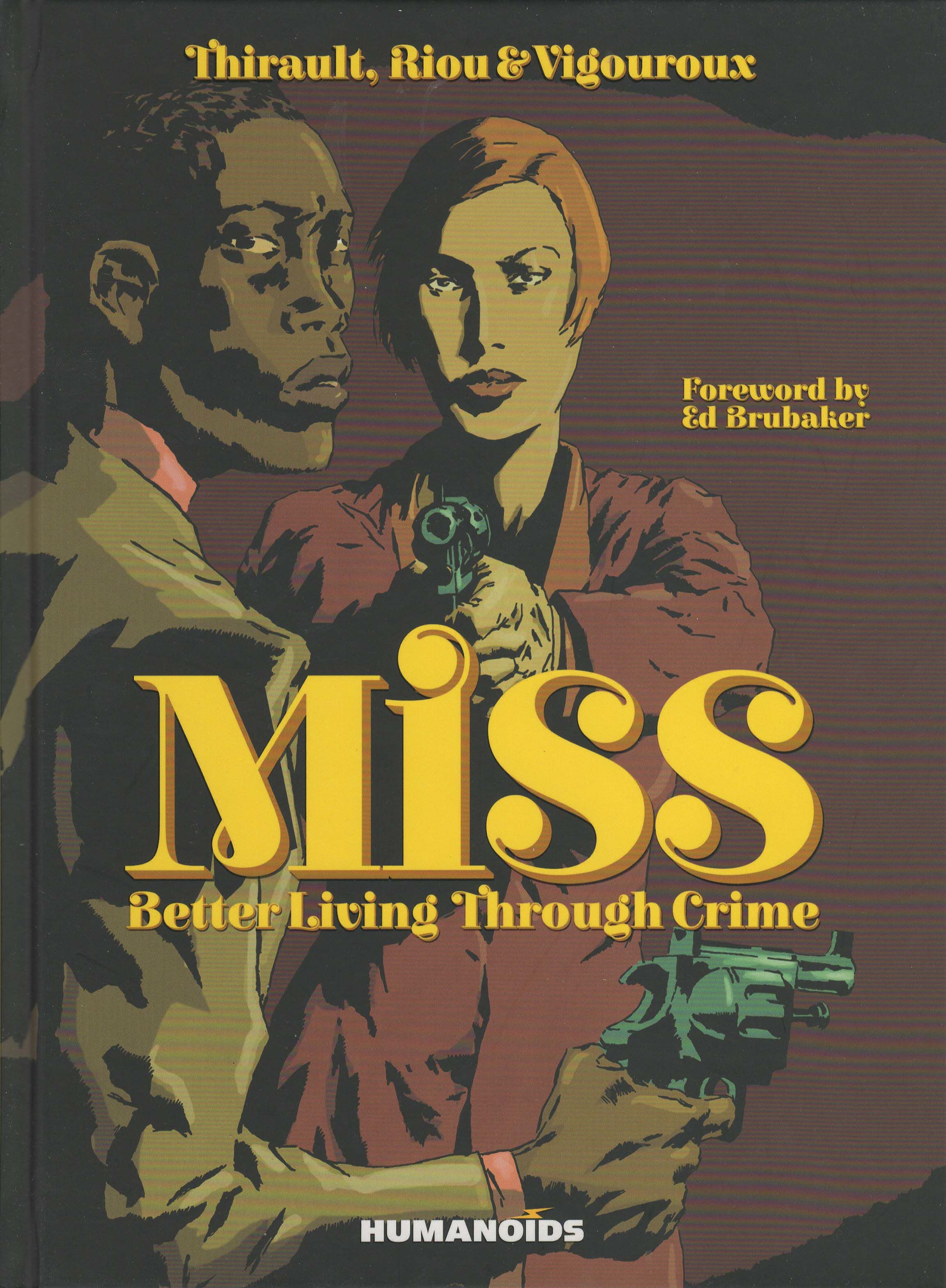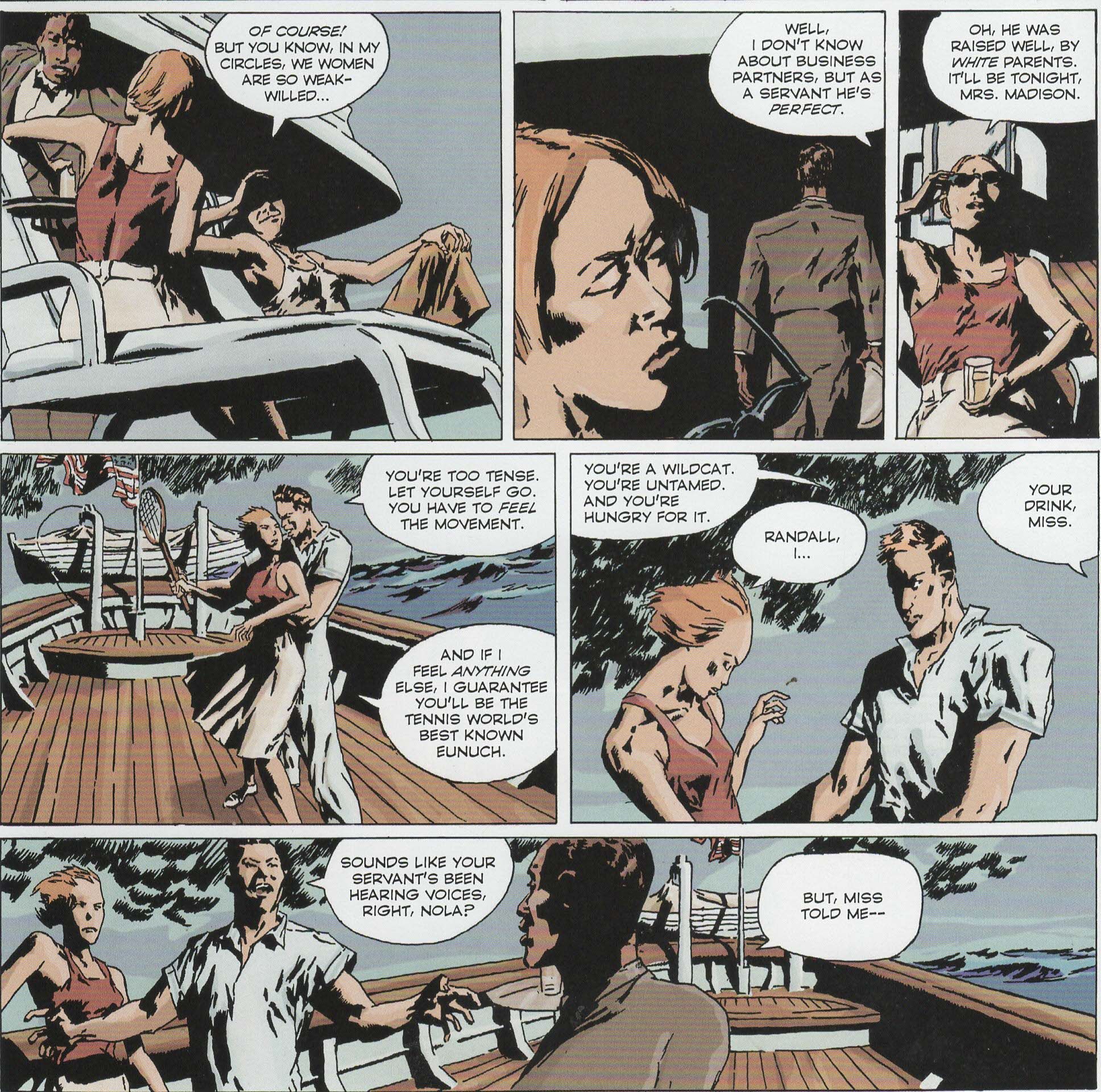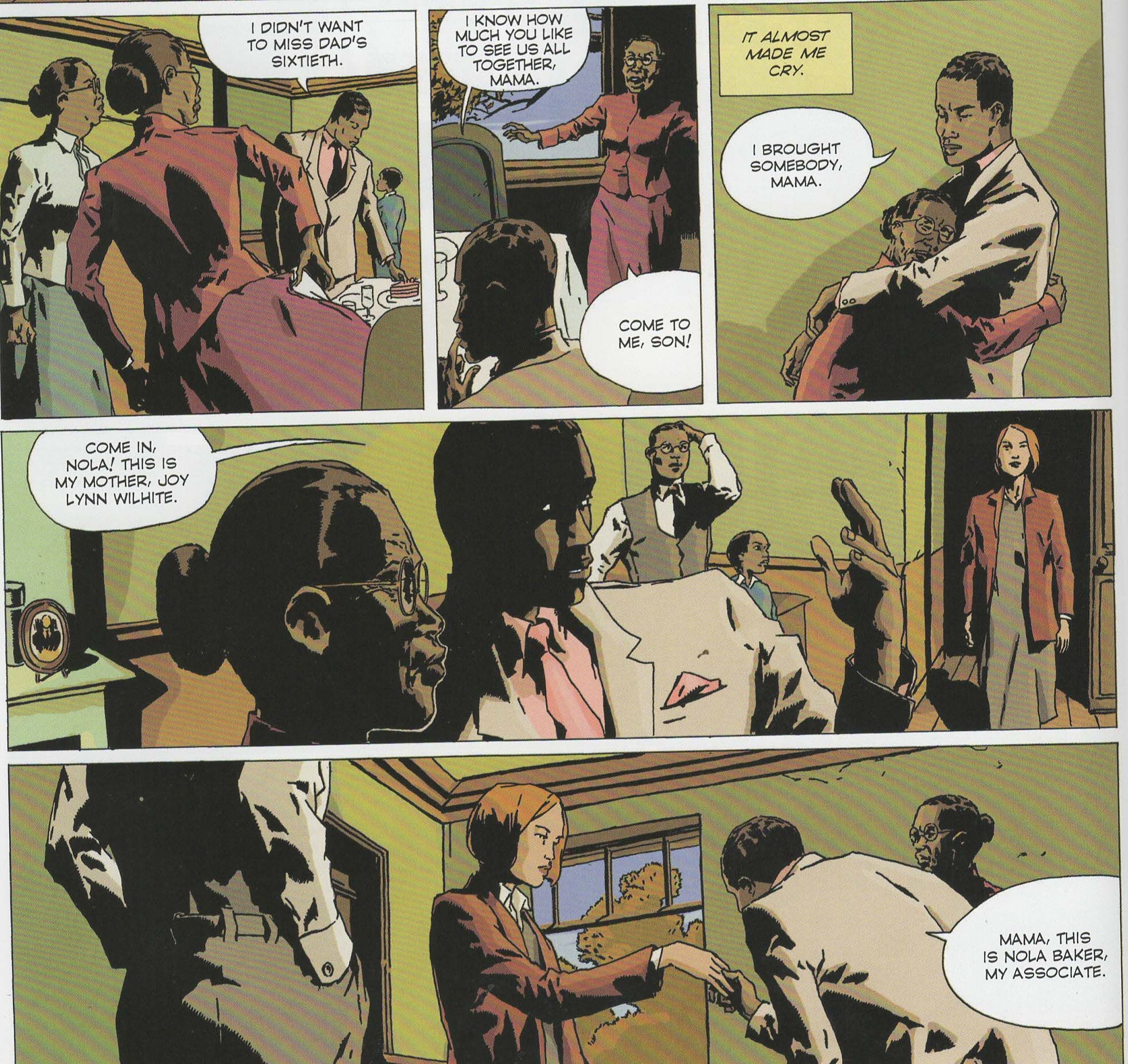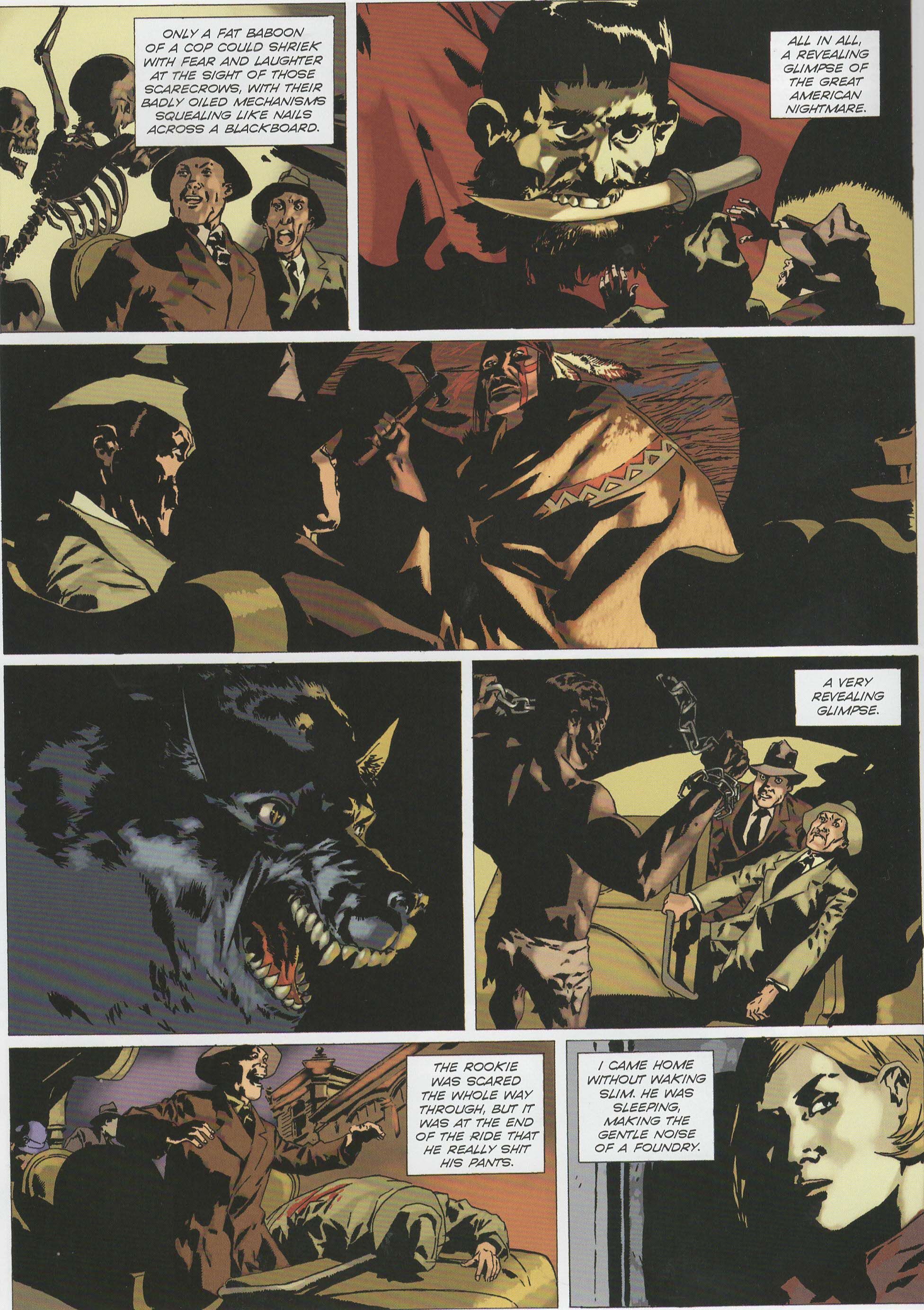"They headed down south and they're still running today"
Another day, another Humanoids publication, as this time it's the four chapters of Miss: Better Living Through Crime, collected in one fancy hardcover for $29.99. It's written by Philippe Thirault, drawn by Marc Riou and Mark Vigouroux (I'm not sure who does what, though), colored by Scarlett Smulkowski and Marc Males, translated by Justin Kelly and Natacha Ruck, and edited by Alex Donoghue.
Plus, you know, Ed Brubaker provides a foreword, and you don't want to miss that!
I have no idea how old Miss is, because Humanoids reprints these for an ignorant American audience, so it could be relatively new or a decade or more old, for all I know. I can't figure it out from yonder Internet, but it appears to be at least six years old. Whatever. I just like to point these things out. Anyway, the comic is easy to summarize: it takes place in 1920s New York (with a brief foray into the 1930s in the last chapter), and the protagonists are a white woman and a black man. If you think that Thirault made them a black man and a white woman to comment on the social inequality that existed in the United States during the Twenties, well, give yourself a gold star. Oh, and they're assassins. Of course they are!
How they get to that point is fascinating, actually, because Thirault does use the way society views women and minorities to get them there. Nola has a difficult life after her father dies and her mother abandons her, as she is placed in an orphanage and beaten by the nuns. When they kick her out, she is approached by a man who, it turns out, is a private investigator ... and not a very good one, as we soon learn.
He takes a job to kill his landlord's rival and send Nola to get a gun from a man in Harlem. There she meets Slim, a pimp, but nothing comes of it except violence, as gangsters are trying to kill him because he owes money to a crime boss. Eventually, they have a drink, and he tells her if she ever needs anything, she should look him up. Her boss gets killed when he tries to pull his job, and Nola has to take care of the targets, which makes her realize she has a propensity for killing. It seems only logical that she should take up the gig, and she enlists Slim as a partner. Mayhem ensues.
Nola and Slim are remarkably successful at their jobs, and they begin to move in better circles, as Slim becomes close to the crime boss to whom he owed the money (he eventually paid him) and they navigate both the dangerous spheres of the Harlem underworld and New York high society. Thirault does a very nice job with the casual racism and sexism of the period - Nola is more easily able to pass herself off as a lady, so she isn't as scrutinized as Slim, while he can pass unnoticed into places because everyone thinks he's a servant. Thirault doesn't pull any punches - people say all kinds of racist things, and we see how society is structured to separate the races - but he also delves quite nicely into black society beyond a stereotypical view of the Harlem Renaissance, for instance.
Slim isn't as bad off as we think he is, as his family is quite wealthy and they live in a nice section of town, albeit one that the whites have left so now the blacks are "allowed" to move into it. Pat Horall, the crime boss, finances movies and lives an outwardly respectable life, even though he's a criminal. The cast is largely black, and Thirault does a very good job showing how they negotiate through this world that is stacked against them - they don't protest because they know it would do no good, but they figure out ways to make their lives as good as possible. Nola, as someone who also comes from the wrong side of the tracks, is far more sympathetic to Slim's plight than most, but even she can't really change anything, and the most crushing parts of the book are when Slim is not allowed into houses or other places because of his skin color, even though the people they're visiting want to hire him to kill people for them. Thirault doesn't have to comment on the irony when it's so glaring, and it's better that he doesn't.
Through their jobs, we also get a really nice sense of the world of 1920s New York. The book is packed with minor yet interesting characters, from the small business owners in Harlem, the thugs who work for the crime bosses, the idle rich and their effortless sense of privilege, the prostitutes who are loyal to Slim, the middle-class blacks, the religious zealots, and the women on the margins.
All of the characters are looking for an angle, and it makes the drama rawer, because everyone is playing everyone else, so the entire book feels more dangerous. Thirault isn't afraid to kill random people who have no connection to crime - it's just a violent world - and he never shies away from the cruelty that people inflict on each other - not just the racism, but the petty meanness of people who have either no hope for the future or no fear from the law. In this sense, Nola and Slim become avenging angels - they kill for money, sure, and they kill people who others want dead, but in one instance, Nola refuses to kill someone (for a very good reason), and in other cases, the people they kill deserve it. They might not have many morals, but they do have a bit of a code, and that makes them slightly more admirable than most of the people in the book. Thirault builds their relationship slowly and well, as they find in each other something they couldn't find anywhere else - not only a purpose, but a sense that the other knows exactly how they feel because they've been through the same thing - and while some of the leaps in the romantic narrative are a bit strange, their story holds the disparate plots together really well. Each small event that they need to overcome binds them together a bit more, so their relationship feels more organic.
The book is very violent, of course, and Riou and Vigouroux do quite a nice job with that and with the rest of the art, as well.
The art has an odd, rough style - the characters always seem a bit too elongated, which is a weird criticism, I know, but it makes them look slightly unreal. However, that's a minor thing, because the art does work well to depict the tableau of 1920s New York. The artists give us a New York that's large and sprawling, naturally, but still looks vaguely rural, which is weird but feels fitting. Even among the buildings, there's a sense that it hasn't become the steel and brick metropolis it is today, and you can still find open spaces in Manhattan. It adds to the olde-tymey feel of the book, as if the city still doesn't know what it is and is trying to figure it out, which becomes a metaphor for the characters and even the country. New York is still an urban place, but the subtle ways the artist draws its streets and buildings give it a slight Wild West vibe, and considering the lawlessness that runs rampant in the streets (Nola and Slim never seem to have any problem committing their murders and getting away with them), it's an apt comparison. The coloring helps that, too, as the streets are often brown, so that even if we can tell they're paved, they make New York look like a dusty outpost on the prairie. The way the artists draw the two leads is nice, too, as their body language is wonderful throughout - they trust each other implicitly and have each other's backs, and Riou and Vigouroux working well in concert and taking care of each other. While Thirault gets the macro-racism well, the artists get the micro-racism very nicely, too, with dismissive looks on the faces of even lower-class whites (a butler in one scene is satisfied to look down his nose at Slim) that tell as much as the words the characters speak. The clothing the characters wear is very nice, too, and it gets back to the idea that the black community was as stratified as the white community - we get middle-class blacks who dress in suits and beautiful dresses, while the lower-classes are a bit rougher. The interiors of the buildings are excellent, too, as we get a very good sense of the way life worked during the 1920s.
The digital coloring in the final chapter is a bit unfortunate, because it's not as good as the earlier ones - too much Photoshopping, it appears, and the spot blacks that make the art crisp in the first three chapters are smoothed out too much - but it's not as bad as it could be. The book has a good, earthy feel to it - it looks like something that takes place in the 1920s, which is hard to do.
Miss is a good noir book, full of ethically gray characters and fascinating social circumstances that make the plots - which are, after all, just about two people killing people who tend to need killing - better, as nothing is simple for a woman and a black man in this world. Nola and Slim are great characters, as they are well equipped to move in this society and make it work for them. Life might be cheap in this comic, but what's nice about Nola and Slim is that they slowly learn that some things are worth living for, and Thirault does a nice job with that journey throughout the book. As with all Humanoids books, it's a bit spendy, but also as with European comics, it's packed, as no space is wasted, so it's a nice, immersive reading experience. And Ed Brubaker likes it, so there!
Rating: ★ ★ ★ ★ ★ ★ ★ ☆ ☆ ☆







